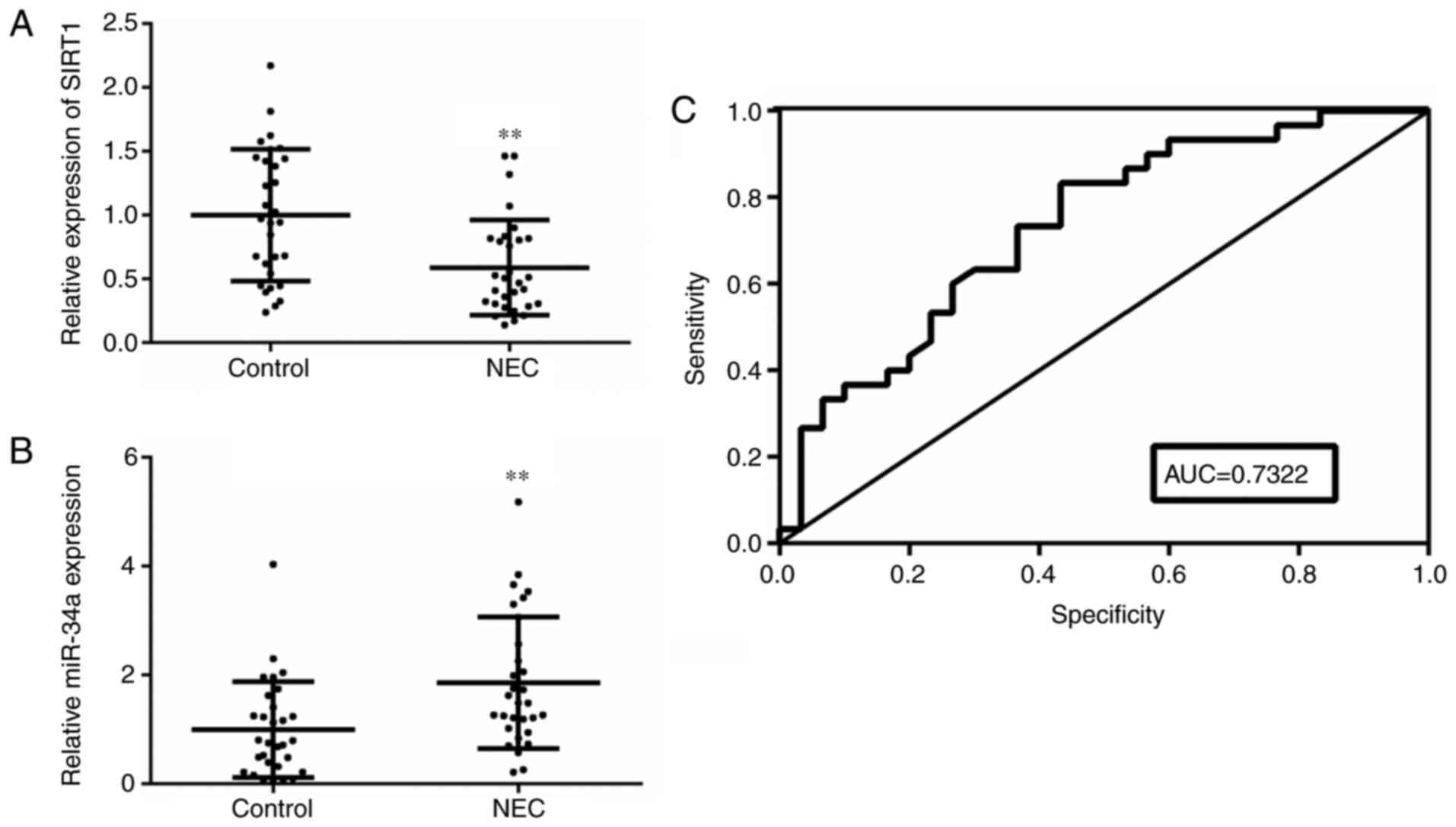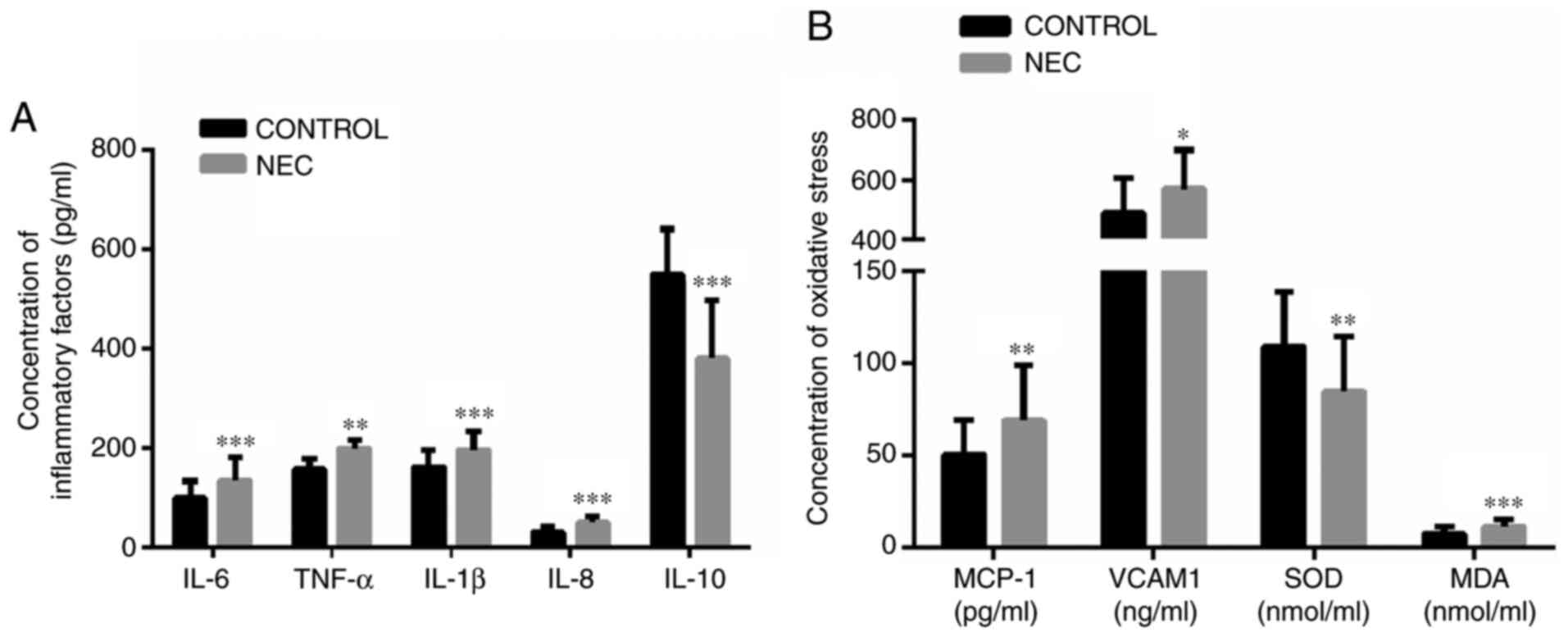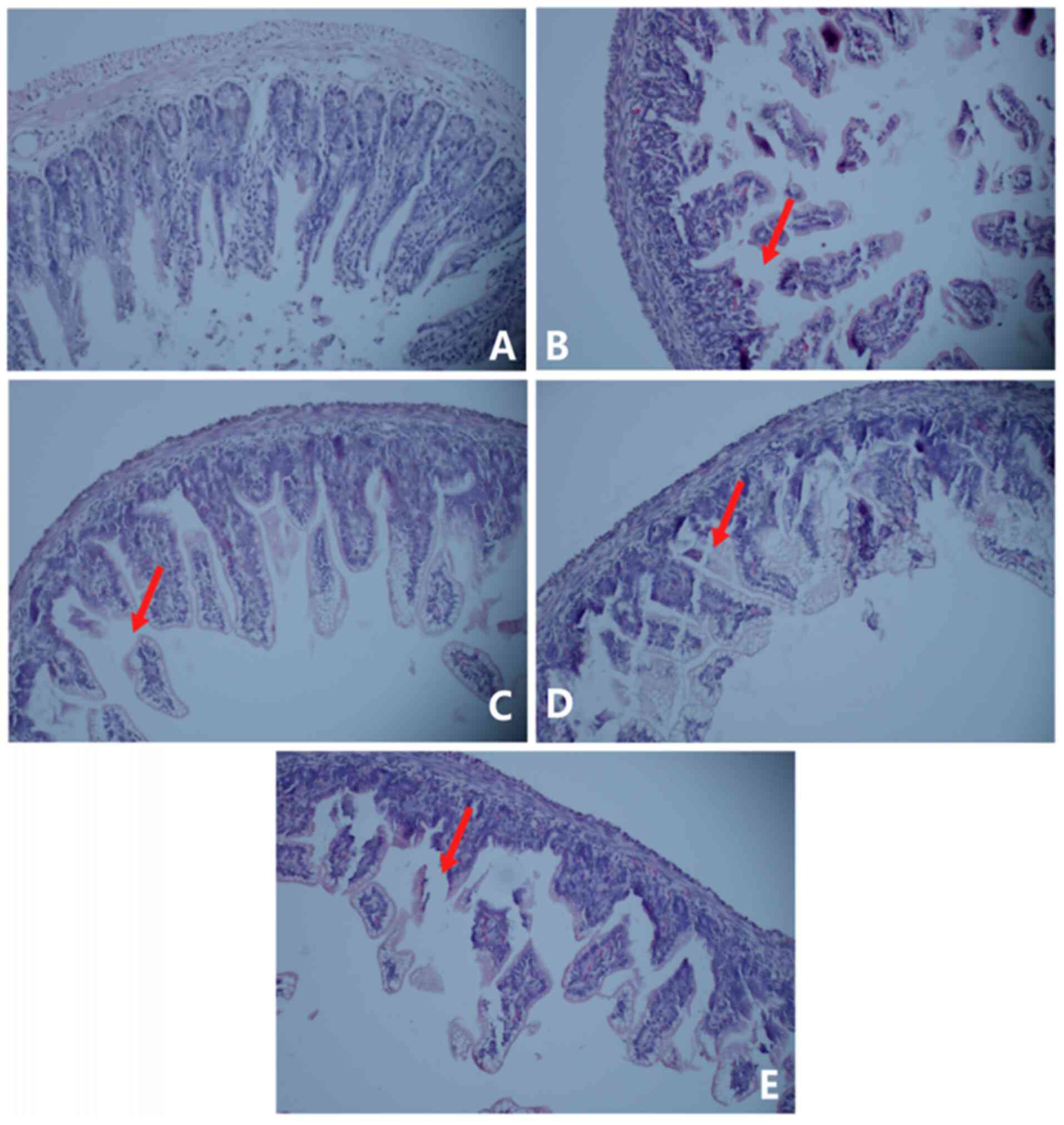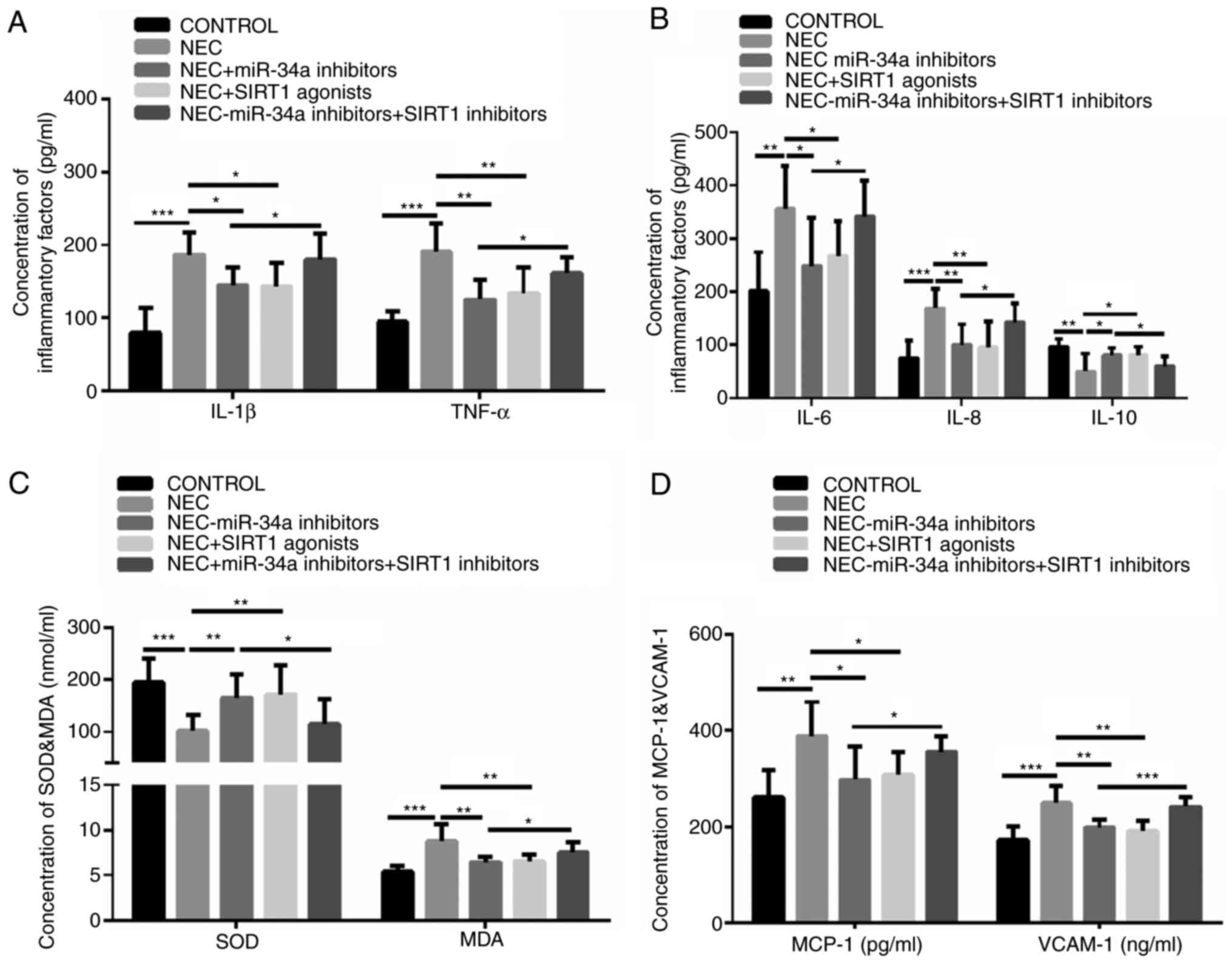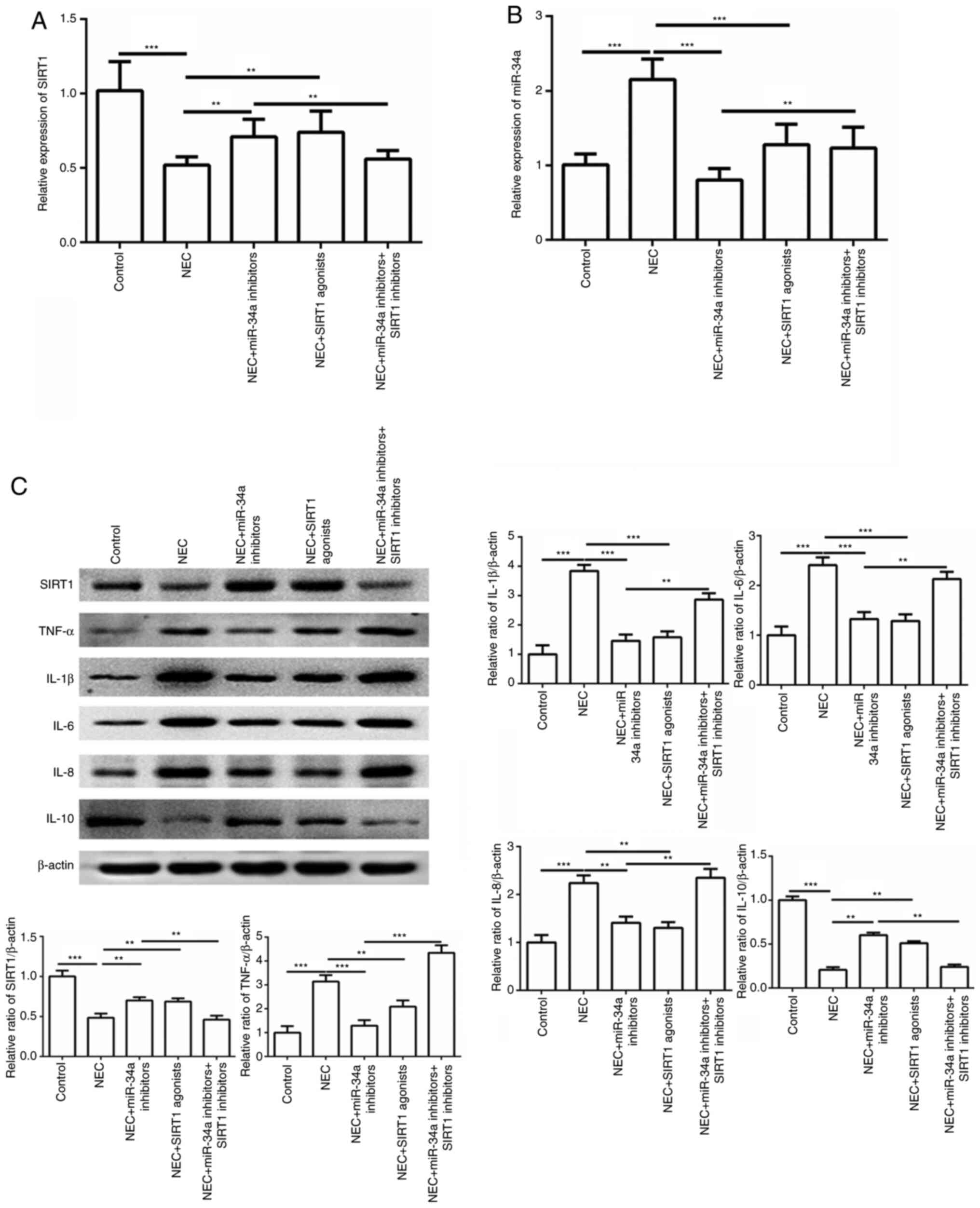|
1
|
Neu J and Walker WA: Necrotizing
enterocolitis. N Engl J Med. 364:255–264. 2011. View Article : Google Scholar : PubMed/NCBI
|
|
2
|
Bein A, Eventov-Friedman S, Arbell D and
Schwartz B: Intestinal tight junctions are severely altered in NEC
preterm neonates. Pediatr Neonatol. 59:464–473. 2018. View Article : Google Scholar : PubMed/NCBI
|
|
3
|
Yin Y, Wu X, Peng B, Zou H, Li S, Wang J
and Cao J: Curcumin improves necrotising microscopic colitis and
cell pyroptosis by activating SIRT1/NRF2 and inhibiting the TLR4
signalling pathway in newborn rats. Innate Immun. 26:609–617. 2020.
View Article : Google Scholar : PubMed/NCBI
|
|
4
|
Mikuš P, Pecher D, Rauová D, Horváth C,
Szobi A and Adameova A: Determination of novel highly effective
necrostatin Nec-1s in rat plasma by high performance liquid
chromatography hyphenated with quadrupole-time-of-flight mass
spectrometry. Molecules. 23:19462018. View Article : Google Scholar
|
|
5
|
Xu Y, Liu Y, Xie H, Zhou Y, Yan X, Chen W,
Wang X, Yu Z, Wang F, Chen X, et al: Profile analysis reveals
endogenous RNAs regulate necrotizing enterocolitis progression.
Biomed Pharmacother. 125:1099752020. View Article : Google Scholar : PubMed/NCBI
|
|
6
|
Chen JF, Mandel EM, Thomson JM, Wu Q,
Callis TE, Hammond SM, Conlon FL and Wang DZ: The role of
microRNA-1 and microRNA-133 in skeletal muscle proliferation and
differentiation. Nat Genet. 38:228–233. 2006. View Article : Google Scholar : PubMed/NCBI
|
|
7
|
Lee RC, Feinbaum RL and Ambros V: The C.
Elegans heterochronic gene lin-4 encodes small RNAs with antisense
complementarity to lin-14. Cell. 75:843–854. 1993. View Article : Google Scholar : PubMed/NCBI
|
|
8
|
Bartel DP: MicroRNAs: Genomics,
biogenesis, mechanism, and function. Cell. 116:281–297. 2004.
View Article : Google Scholar : PubMed/NCBI
|
|
9
|
Liu H and Wang YB: Systematic large-scale
meta-analysis identifies miRNA-429/200a/b and miRNA-141/200c
clusters as biomarkers for necrotizing enterocolitis in newborn.
Biosci Rep. 39:BSR201915032019. View Article : Google Scholar : PubMed/NCBI
|
|
10
|
Ng PC, Chan KYY, Yuen TP, Sit T, Lam HS,
Leung KT, Wong RPO, Chan LCN, Pang YLI, Cheung HM, et al: Plasma
miR-1290 is a novel and specific biomarker for early diagnosis of
necrotizing enterocolitis-biomarker discovery with prospective
cohort evaluation. J Pediatr. 205:83–90.e10. 2019. View Article : Google Scholar : PubMed/NCBI
|
|
11
|
Vandenboom Ii TG, Li Y, Philip PA and
Sarkar FH: MicroRNA and cancer: Tiny molecules with major
implications. Curr Genomics. 9:97–109. 2008. View Article : Google Scholar : PubMed/NCBI
|
|
12
|
Shi XL, Kaller M, Rokavec M, Kirchner T,
Horst D and Hermeking H: Characterization of a
p53/miR-34a/CSF1R/STAT3 feedback loop in colorectal cancer. Cell
Mol Gastroenterol Hepatol. 10:391–418. 2020. View Article : Google Scholar : PubMed/NCBI
|
|
13
|
Slabáková E, Culig Z, Remšík J and Souček
K: Alternative mechanisms of miR-34a regulation in cancer. Cell
Death Dis. 8:e31002017. View Article : Google Scholar
|
|
14
|
Mathé E, Nguyen GH, Funamizu N, He P,
Moake M, Croce CM and Hussain SP: Inflammation regulates microRNA
expression in cooperation with p53 and nitric oxide. Int J Cancer.
131:760–765. 2012. View Article : Google Scholar
|
|
15
|
Rokavec M, Li H, Jiang L and Hermeking H:
The p53/miR-34 axis in development and disease. J Mol Cell Biol.
6:214–230. 2014. View Article : Google Scholar : PubMed/NCBI
|
|
16
|
Li XJ, Zhang WY, Xu K and Lu J: miR-34a
promotes liver fibrosis in patients with chronic hepatitis via
mediating Sirt1/p53 signaling pathway. Pathol Res Pract.
216:1528762020. View Article : Google Scholar : PubMed/NCBI
|
|
17
|
Wang H, Jiao H, Jiang Z and Chen R:
Propofol inhibits migration and induces apoptosis of pancreatic
cancer PANC-1 cells through miR-34a-mediated E-cadherin and
LOC285194 signals. Bioengineered. 11:510–521. 2020. View Article : Google Scholar : PubMed/NCBI
|
|
18
|
Li B, Guo X, Li N, Chen Q, Shen J, Huang
X, Huang G and Wang F: WNT1, a target of miR-34a, promotes cervical
squamous cell carcinoma proliferation and invasion by induction of
an E-P cadherin switch via the WNT/β-catenin pathway. Cell Oncol
(Dordr). 43:489–503. 2020. View Article : Google Scholar : PubMed/NCBI
|
|
19
|
Rokavec M, Öner MG, Li H, Jackstadt R,
Jiang L, Lodygin D, Kaller M, Horst D, Ziegler PK, Schwitalla S, et
al: IL-6R/STAT3/miR-34a feedback loop promotes EMT-mediated
colorectal cancer invasion and metastasis. J Clin Invest.
124:1853–1867. 2014. View
Article : Google Scholar : PubMed/NCBI
|
|
20
|
Concepcion CP, Han YC, Mu P, Bonetti C,
Yao E, D'Andrea A, Vidigal JA, Maughan WP, Ogrodowski P and Ventura
A: Intact p53-dependent responses in miR-34-deficient mice. PLoS
Genet. 8:e10027972012. View Article : Google Scholar : PubMed/NCBI
|
|
21
|
Barangi S, Mehri S, Moosavi Z, Hayesd AW,
Reiter RJ, Cardinali DP and Karimi G: Melatonin inhibits
Benzo(a)pyrene-induced apoptosis through activation of the
Mir-34a/Sirt1/autophagy pathway in mouse liver. Ecotoxicol Environ
Saf. 196:1105562020. View Article : Google Scholar : PubMed/NCBI
|
|
22
|
Park J, Kim J, Chen Y, Song HC, Chen Y,
Zheng M, Surh YJ, Kim UH, Park JW, Joe Y and Chung HT: CO
ameliorates cellular senescence and aging by modulating the
miR-34a/Sirt1 pathway. Free Radic Res. 54:848–858. 2020. View Article : Google Scholar : PubMed/NCBI
|
|
23
|
Xiang Q, Kang L, Wang J, Liao Z, Song Y,
Zhao K, Wang K, Yang C and Zhang Y: CircRNA-CIDN mitigated
compression loading-induced damage in human nucleus pulposus cells
via miR-34a-5p/SIRT1 axis. EBioMedicine. 53:1026792020. View Article : Google Scholar : PubMed/NCBI
|
|
24
|
Auestad N, Korsak RA, Bergstrom JD and
Edmond J: Milk-substitutes comparable to rat's milk; their
preparation, composition and impact on development and metabolism
in the artificially reared rat. Br J Nutr. 61:495–518. 1989.
View Article : Google Scholar : PubMed/NCBI
|
|
25
|
Ozdemir R, Yurttutan S, Sari FN, Oncel MY,
Erdeve O, Unverdi HG, Uysal B and Dilmen U: All-trans-retinoic acid
attenuates intestinal injury in a neonatal rat model of necrotizing
enterocolitis. Neonatology. 104:22–27. 2013. View Article : Google Scholar : PubMed/NCBI
|
|
26
|
Afrazi A, Sodhi CP, Good M, Jia H, Siggers
R, Yazji I, Ma C, Neal MD, Prindle T, Grant ZS, et al:
Intracellular heat shock protein-70 negatively regulates TLR4
signaling in the newborn intestinal epithelium. J Immunol.
188:4543–4557. 2012. View Article : Google Scholar : PubMed/NCBI
|
|
27
|
Xie Z, Zhang J, Ma S, Huang X and Huang Y:
Effect of Chinese herbal medicine treatment on plasma lipid profile
and hepatic lipid metabolism in Hetian broiler. Poult Sci.
96:1918–1924. 2017. View Article : Google Scholar : PubMed/NCBI
|
|
28
|
Xie Z, Wang Y, Huang J, Qian N, Shen G and
Chen L: Anti-inflammatory activity of polysaccharides from
phellinus linteus by regulating the NF-κB translocation in
LPS-stimulated RAW264.7 macrophages. Int J Biol Macromol.
129:61–67. 2019. View Article : Google Scholar : PubMed/NCBI
|
|
29
|
Emami CN, Petrosyan M, Giuliani S,
Williams M, Hunter C, Prasadarao NV and Ford HR: Role of the host
defense system and intestinal microbial flora in the pathogenesis
of necrotizing enterocolitis. Surg Infect (Larchmt). 10:407–417.
2009. View Article : Google Scholar : PubMed/NCBI
|
|
30
|
Su ZR, Zhi XF, Zhang Q, Yang L, Xu H and
Xu ZK: LncRNA H19 functions as a competing endogenous RNA to
regulate AQP3 expression by sponging miR-874 in the intestinal
barrier. FEBS Lett. 590:1354–1364. 2016. View Article : Google Scholar : PubMed/NCBI
|
|
31
|
Heverhagen AE, Legrand N, Wagner V,
Fendrich V, Bartsch DK and Slater EP: Overexpression of MicroRNA
miR-7-5p is a potential biomarker in neuroendocrine neoplasms of
the small intestine. Neuroendocrinology. 106:312–317. 2018.
View Article : Google Scholar : PubMed/NCBI
|
|
32
|
Vaira V, Roncoroni L, Barisani D, Gaudioso
G, Bosari S, Bulfamante G, Doneda L, Conte D, Tomba C, Bardella MT,
et al: microRNA profiles in coeliac patients distinguish different
clinical phenotypes and are modulated by gliadin peptides in
primary duodenal fibroblasts. Clin Sci (Lond). 126:417–423. 2014.
View Article : Google Scholar : PubMed/NCBI
|
|
33
|
Bansal A, Hong XM, Lee IH, Krishnadath KK,
Mathur SC, Gunewardena S, Rastogi A, Sharma P and Christenson LK:
MicroRNA expression can be a promising strategy for the detection
of Barrett's esophagus: A pilot study. Clin Transl Gastroenterol.
5:e652014. View Article : Google Scholar : PubMed/NCBI
|
|
34
|
Martin CR and Walker WA: Intestinal immune
defences and the inflammatory response in necrotising
enterocolitis. Semin Fetal Neonatal Med. 11:369–377. 2006.
View Article : Google Scholar : PubMed/NCBI
|
|
35
|
Li J, Wang K, Chen X, Meng H, Song M, Wang
Y, Xu X and Bai Y: Transcriptional activation of microRNA-34a by
NF-kappa B in human esophageal cancer cells. BMC Mol Biol.
13:42012. View Article : Google Scholar : PubMed/NCBI
|
|
36
|
Tazawa H, Tsuchiya N, Izumiya M and
Nakagama H: Tumor-suppressive miR-34a induces senescence-like
growth arrest through modulation of the E2F pathway in human colon
cancer cells. Proc Natl Acad Sci USA. 104:15472–15477. 2007.
View Article : Google Scholar : PubMed/NCBI
|
|
37
|
Bommer GT, Gerin I, Feng Y, Kaczorowski
AJ, Kuick R, Love RE, Zhai Y, Giordano TJ, Qin ZS, Moore BB, et al:
p53-mediated activation of miRNA34 candidate tumor-suppressor
genes. Curr Biol. 17:1298–1307. 2007. View Article : Google Scholar : PubMed/NCBI
|
|
38
|
Yamakuchi M, Ferlito M and Lowenstein CJ:
miR-34a repression of SIRT1 regulates apoptosis. Proc Natl Acad Sci
USA. 105:13421–13426. 2008. View Article : Google Scholar : PubMed/NCBI
|
|
39
|
Ji ML, Jiang H, Zhang XJ, Shi PL, Li C, Wu
H, Wu XT, Wang YT, Wang C and Lu J: Preclinical development of a
microRNA-based therapy for intervertebral disc degeneration. Nat
Commun. 9:50512018. View Article : Google Scholar : PubMed/NCBI
|
|
40
|
Gupta SK, Foinquinos A, Thum S, Remke J,
Zimmer K, Bauters C, de Groote P, Boon RA, de Windt LJ, Preissl S,
et al: Preclinical development of a MicroRNA-based therapy for
elderly patients with myocardial infarction. J Am Coll Cardiol.
68:1557–1571. 2016. View Article : Google Scholar : PubMed/NCBI
|
|
41
|
Xia X, Guo J, Lu F and Jiang J: SIRT1
plays a protective role in intervertebral disc degeneration in a
puncture-induced rodent model. Spine (Phila Pa 1976). 40:E515–E524.
2015. View Article : Google Scholar : PubMed/NCBI
|















